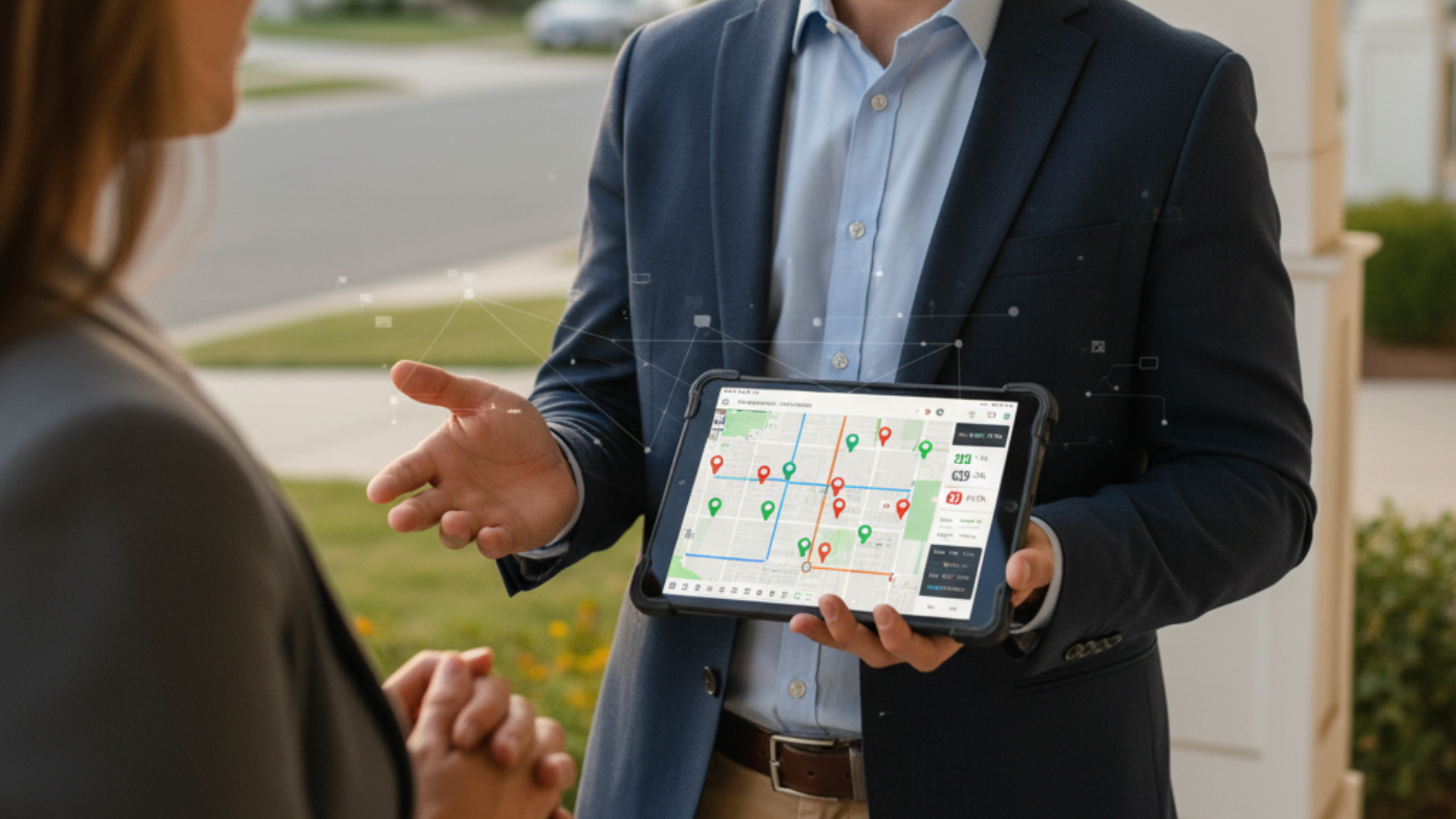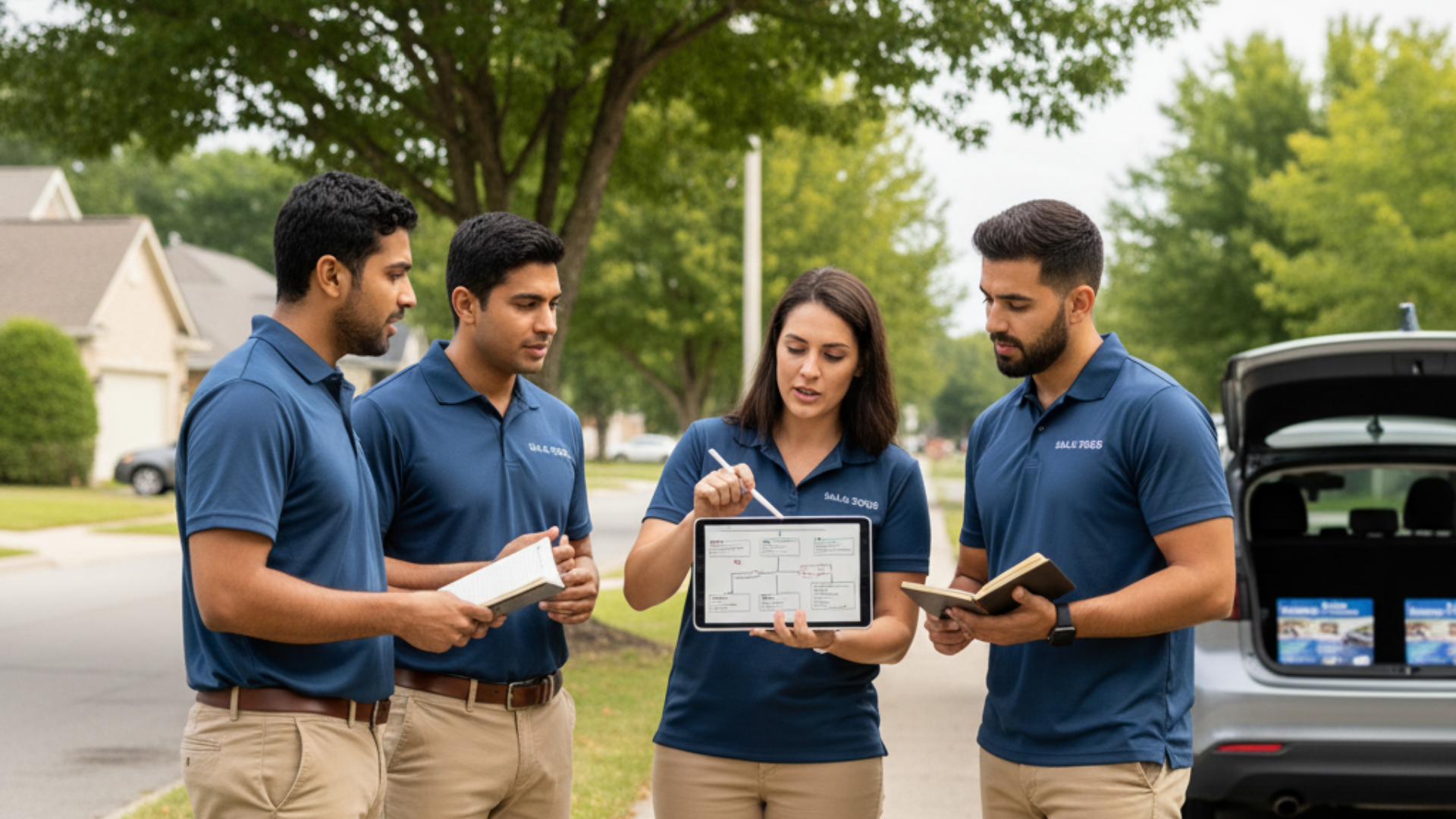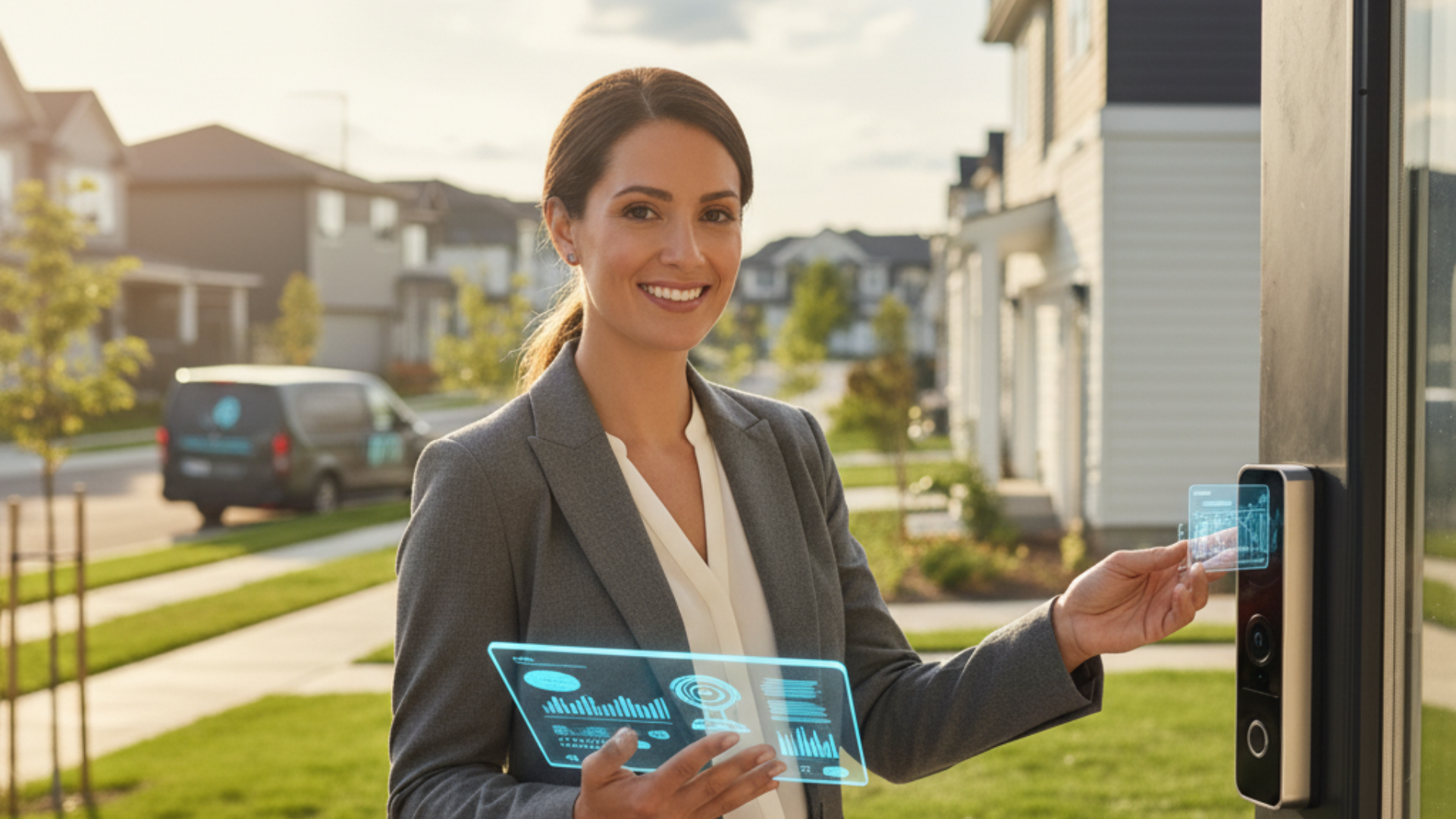“Digital marketing leads for home services cost between $66 and $82, while traditional methods can range anywhere from $51 to well over $1,000 depending on the channel.”
For roofing, solar, and HVAC companies already battling intense competition, it's not just a number - it’s a wake-up call.
The simple truth is that acquiring a new customer has never been more expensive, and every dollar you put into lead generation needs to deliver real returns.
That’s why so many home service entrepreneurs are asking: should I double down on the human touch of door-to-door canvassing, or go all-in on scalable digital campaigns?
In this blog, we’ll break down both sides without the fluff, looking closely at customer acquisition cost (CAC), conversion rates, and lifetime value (LTV). By the end, you’ll have a clear, data-driven picture of where your marketing budget can work hardest in 2025.
D2D vs Digital Leads: What Delivers Better ROI in 2025?
When it comes to D2D vs digital marketing, every home service business faces the same challenge: where should you put your dollars for maximum return?
Door-to-door marketing offers the human touch, personal interaction, and genuine connections that foster trust quickly, while digital marketing utilizes data-driven tools, content marketing, and online strategies to reach a broader audience.
In 2025, the real winners are the companies that know how to balance both worlds.
Key Takeaways
- Home services marketing costs are rising, making every dollar spent on lead generation critical for ROI.
- Door-to-door marketing builds trust and converts locally, while digital marketing scales reach and automation.
- Both D2D and digital channels have unique strengths and challenges; neither alone is the ultimate solution.
- A hybrid strategy that combines personal interaction with digital follow-up maximizes conversions and fosters customer loyalty.
- Technology platforms like Knockbase can integrate field and digital efforts, turning leads into measurable growth.
Understanding the Lead Generation Landscape in Home Services
The home services industry, particularly in areas such as roofing, solar, and HVAC, is fiercely competitive. The U.S. HVAC market alone is projected to reach USD 54.02 billion by 2033, according to Grand View Research, while solar and roofing continue to surge with rising homeowner demand.
With more businesses competing for the same target customers, the cost of reaching prospects is increasing.
- Why digital marketing costs are rising: A single roofing lead can cost $50–$300 from vendors, while Google Ads in home services often run $50–$110 per click. Intense competition drives up CPL, making budgets harder to control.
- The Power of Door-to-Door Engagement: D2D marketing builds trust, personal interaction, and genuine connections. A skilled door salesperson can convert 1 in 10–15 homes, with conversion rates during storm zones hitting much higher. Plus, costs remain more predictable since they’re tied to labor and territory, not ad auctions.
Door-to-Door (D2D) Marketing: What Is It & Why It Still Works
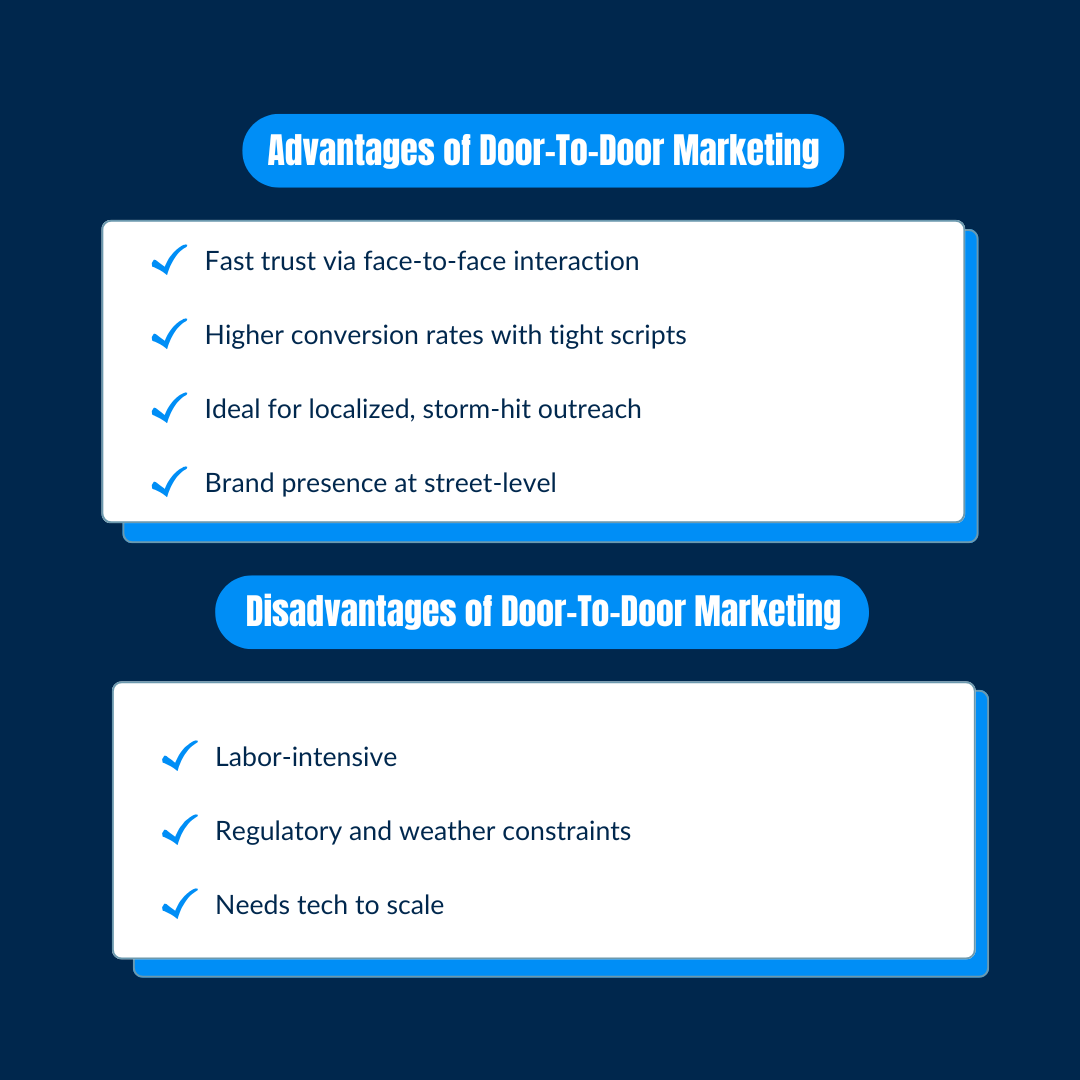
Door-to-Door (D2D) Marketing is a direct sales approach where trained door salespeople canvas targeted neighborhoods, offer quick inspections or estimates, and book appointments on the spot.
Modern teams pair this with digital tools (territory maps, lead capture, instant scheduling) to manage leads and track results in real time.
Advantages of D2D marketing
- Fast trust via face-to-face interaction: People still trust people. 88% of consumers trust recommendations they get from word-of-mouth, and the social proof your reps can trigger at the door (neighbors, referrals) is powerful for target customers.
- Higher conversion rates with tight scripts: This is because reps handle objections live and offer immediate feedback, appointment-set rates, and downstream conversion rates often beat form-fill leads.
- Ideal for localized, storm-hit outreach: The U.S. saw 28 billion-dollar weather disasters in 2023, meaning frequent, hyper-local demand spikes where a human at the door wins.
- Street-level brand presence: Consistent coverage in neighborhoods boosts brand recall and drives referrals, blending traditional methods with modern technology for maximum impact.
Challenges of D2D marketing
- Labor-intensive: Results scale with recruiting, training, routing, and field management; your marketing strategy must include coaching and sessions for sales techniques.
- Regulatory and weather constraints. Some jurisdictions require permits or restrict soliciting on weather stalls on canvassing days.
- Needs tech to scale. Without route optimization, CRM sync, and live dashboards, performance varies and costs creep up; with software, you keep CAC predictable.
Pro tip: Track per-rep appointments set, issued inspections, and net close rate weekly to keep your D2D engine humming.
Digital Marketing: The Scalable Lead Engine
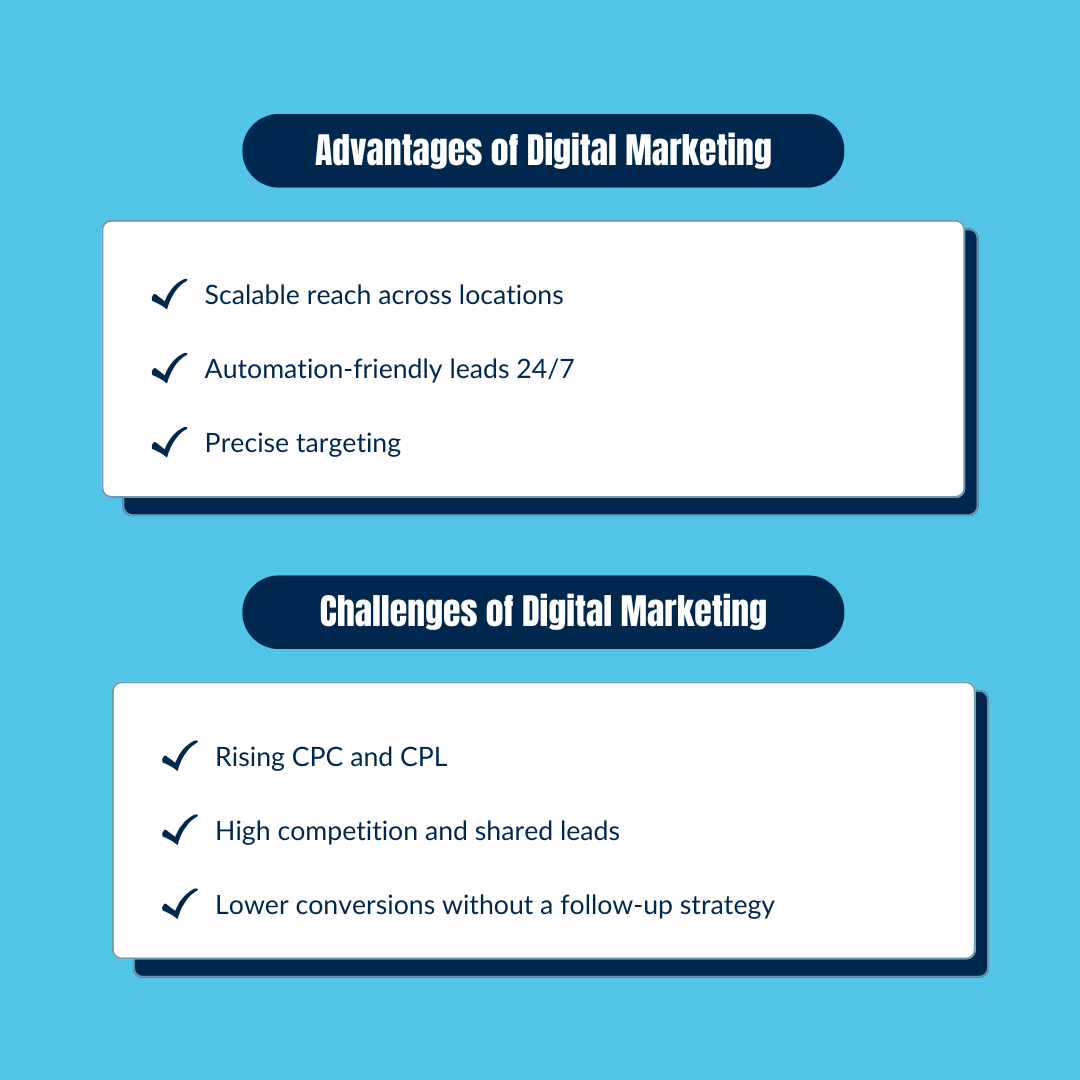
What Counts as Digital Leads
In modern D2D vs. digital marketing, digital leads originate from a rich ecosystem that includes SEO, Google Ads, Facebook/Instagram Ads, email campaigns, and landing pages.
These channels utilize digital tools and content marketing to attract and engage customers, expanding their reach to a larger audience beyond what traditional methods, such as door-to-door marketing, can achieve.
Advantages of Digital Marketing
- Scalable reach across locations: Digital marketing budgets are stretching farther. The global digital marketing industry is projected to $667 billion in 2024, rising to $786 billion by 2026, with search accounting for 40.9% of this growth (WordStream).
- Automation-friendly leads 24/7: Email automation isn’t just convenient, it works. Automated campaigns generate 320% more revenue than non-automated ones, and transactional emails can yield 6× more revenue with 8× the engagement, according to Campaign Monitor.
- Precise targeting: Platforms like Facebook and Instagram enable you to pinpoint target audiences using demographics, interests, and behaviors, providing a more targeted approach than traditional direct marketing.
Challenges of Digital Marketing
- Rising CPC and CPL: In home services, the average CPC is $7.85, with roofing as high as $10.70. Overall, CPL averages $90.92, but roofing and gutters climb to $228.15 (LocaliQ).
- High competition and shared leads: Ads saturate platforms. Even though CTR rose by ~14%, conversion rates dropped around 15% YoY.
- Lower conversions without a follow-up strategy: Raw clicks don't guarantee customers, which leads to declining conversion rates. Customers need to go through an entire customer journey, including multiple touchpoints, before they convert.
The Ultimate Comparison: D2D vs Digital Marketing ROI in 2025
In the digital age, the battle for new customers has never been more intense. For home service companies in roofing, solar, and HVAC, the marketing strategy often comes down to one question: D2D vs digital marketing - which is more cost-effective? Which delivers better ROI?
So, let’s break down the battle between digital campaigns and door-to-door (D2D) marketing across cost, conversion, trust, and long-term impact.
1. Customer Acquisition Cost (CAC)
> Digital Marketing CAC
Average digital marketing CAC has risen 222% over the past eight years.
In 2025, businesses in competitive verticals pay between $600–$1,400+ per customer through online marketing channels like Google Ads and social media.
Rising CPCs, more aggressive advertising, and shared leads mean marketers must invest more effort just to stay visible to their target audience.
Even with digital tools, conversion rates remain low, making managing leads and strong follow-up essential.
> Door-to-Door Marketing CAC
In contrast, door-to-door marketing offers a more controllable path. D2D marketing costs are tied to rep training, door salespeople labor, and territory size, not volatile auctions.
With face-to-face interaction, reps build genuine connections, uncover customer needs in real-time, and establish personal interactions that digital channels can’t match.
For high-ticket services, one door sale can offset weeks of canvassing, delivering ROI far faster than digital.
The Takeaway
The direct sales approach through door-to-door selling may lack the scalability of online marketing, but it provides predictability, human touch, and real-time feedback.
2. A Hard Look at Conversion Rates
> Digital Marketing
That “7.33% average digital conversion rate” is just the headline (LocaliQ); it barely scratches the surface for home services.
What it doesn’t capture is how hard it is to turn a click into a major investment, like a mid-five-figure roofing or solar project. There’s a significant trust gap between seeing an ad and handing over the keys to your home.
> Door-to-Door Marketing
On the flip side, door-to-door marketing (D2D) taps into something digital can’t replicate: the human touch.
Top door salespeople convert at far higher rates because they build genuine connections face-to-face, handle objections in real-time, and convey the value of their services with immediate empathy.
Here’s a revealing stat: home services phone leads convert at about 46%, significantly outperforming digital form leads. That’s nearly half of all callers turning into customers, not a drip funnel, but full-body engagement.
3. Creating Customers for Life (LTV & Retention)
> Digital Marketing
When it comes to D2D vs digital marketing, the real battle isn’t just about generating leads; it’s about keeping customers for life.
Digital campaigns keep your brand in front of customers, but it’s not always personal. Automated emails, retargeting, and personalized content nurture relationships at scale, gently reminding customers to return, but it can feel distant.
While it works well for steady engagement, it doesn’t create the instant trust or loyalty that a real conversation can spark.
> Door-to-door Marketing
On the other hand, D2D builds retention through genuine human interaction. Face-to-face conversations let salespeople address concerns immediately, show care, and make customers feel valued.
That personal touch creates stronger loyalty, making clients more likely to stay, refer others, and trust your services long-term.
4. Automation and Scalable Nurturing
> Digital Marketing
In the digital age, digital marketing shines at nurturing. With digital tools like email, SMS, and retargeting, companies can engage customers consistently and at scale.
These campaigns enable businesses to remain top of mind for their target audience, providing timely reminders, targeted upsells, and relevant content.
For brands looking to manage leads and create repeat business, automation is a powerful tool that saves effort while delivering personalized experiences.
> Door-to-door Marketing
Traditional door-to-door struggles with automation and scaling. Each visit requires a salesperson on-site, which limits how many customers you can reach in a day.
Follow-ups, reminders, and nurturing campaigns must be done manually, making it hard to maintain consistent engagement with every prospect.
Unlike digital marketing, it can’t automatically send emails, retarget visitors, or manage long-term campaigns at scale. This means it’s powerful locally but less efficient for nurturing large audiences over time.
However, by integrating the right CRM tools, automated reminders, and real-time lead tracking, D2D teams can nurture prospects at scale without losing the human touch.
5. Loyalty and Powerful Referrals
> Digital Marketing
While digital marketing can reach a wide audience and keep your brand top of mind through emails, ads, and automated campaigns, it lacks the personal touch that
door-to-door marketing provides.
It engages customers at scale but can’t create the same authentic human connection or immediate trust.
Relationships and loyalty take longer to build online, and referrals are driven more by structured programs than genuine face-to-face interactions.
> D2D Marketing
But door-to-door marketing has its own unfair advantage. Through face-to-face interaction, door salespeople create a direct connection that feels authentic.
This personal touch builds trust in a way no automated message can replicate. Over time, this trust transforms into loyalty, and loyalty naturally sparks referrals.
In fact, a happy customer who experienced that human touch often becomes the strongest advocate, bringing in new prospects at little to no cost.
"Digital marketing builds a sales funnel. Door-to-door builds a human relationship. In 2025, the most profitable home services businesses have figured out how to do both."
D2D vs Digital Marketing: At a Glance
This is the expanded table, incorporating the new criteria for a more comprehensive comparison of lead generation strategies in the home services sector:
| Metric | Digital Marketing | Door-to-Door (D2D) |
|---|---|---|
| Average CAC (2025) | $600 - $1,400+ (High-inten(High-intent) | Lower & more predictable |
| Key Cost Drivers | Ad spend, competition, agency fees | Labor, commissions, travel time |
| Volatility | High (subject to algorithm changes) | Low (tied to operational efficiency) |
| Best For | Broad brand awareness, lead nurturing | High-value local sales, building trust |
| Customer Trust | Moderate (Varies by channel, often seen as transactional) | High (Personal interaction builds immediate rapport) |
| Speed of Results (Initial Leads) | Fast (Can generate leads immediately upon campaign launch) | Moderate (Requires setup, training, and deployment time) |
| Scalability | High (Easily increased budget/territory via platforms) | Moderate (Limited by available skilled labor and training capacity) |
| Follow-up Potential | High (Automated retargeting, email, CRM integration) | Moderate (Relies on salesperson notes and dedicated CRM/canvassing tool) |
| Lead Quality | Variable (Requires high filtering to get "high-intent") | High (Pre-qualified by face-to-face needs assessment) |
| Brand Recall | Moderate to High (Consistent visual/retargeting campaigns) | Very High (Memorable personal interaction) |
| Geographic Reach | Global/National (Limited only by ad targeting) | Hyperlocal (Limited by feasible travel radius/territory) |
The Hybrid Strategy for 2025
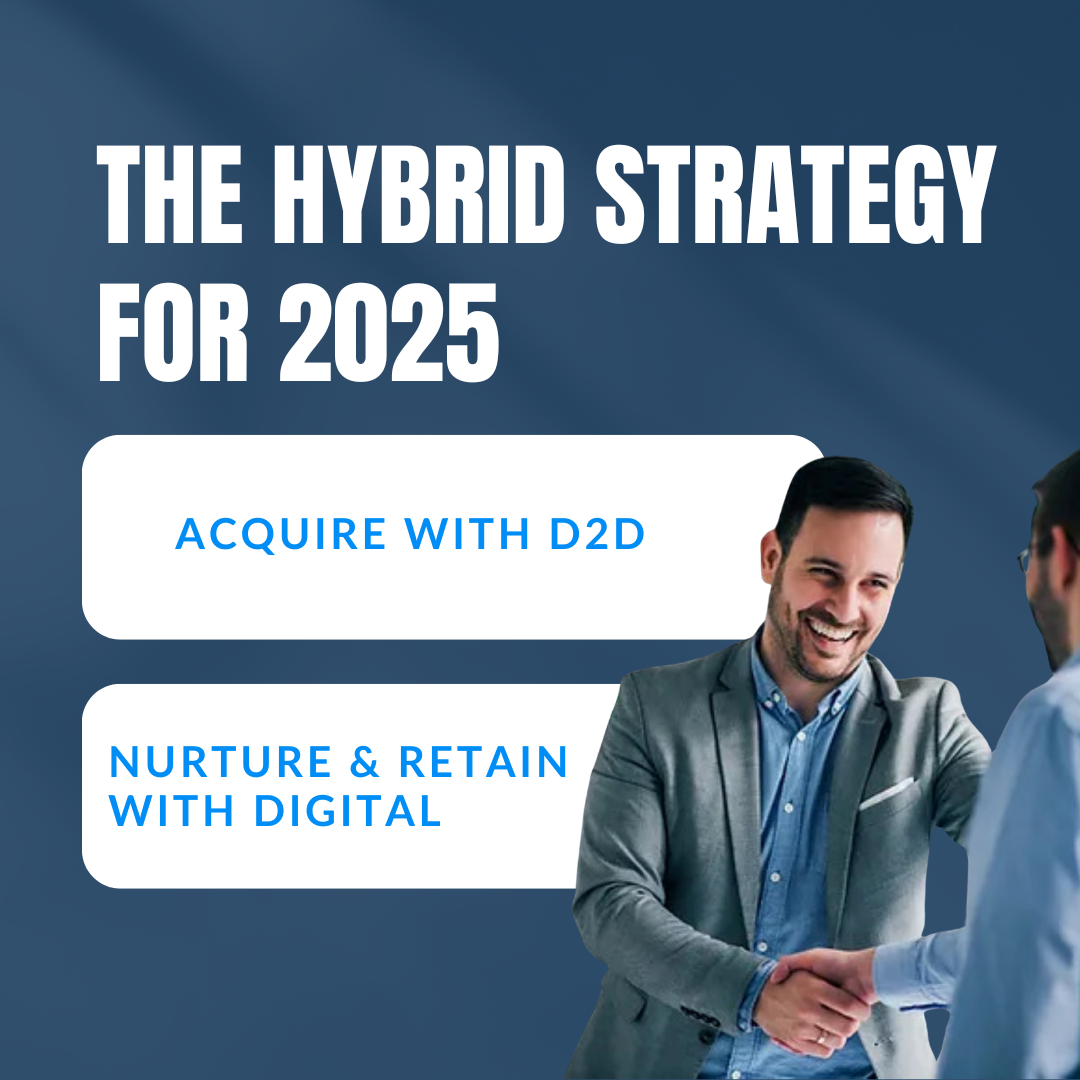
The smartest marketing strategy in 2025 isn’t about choosing sides in the D2D vs digital marketing debate; it’s about blending both.
Door-to-door marketing builds instant trust through face-to-face interaction, while digital marketing nurtures and scales relationships with digital tools.
- Acquire with D2D: Use your field team to build trust and close high-value deals with a predictable CAC.
- Nurture & Retain with Digital: Use the data captured in the field to power automated campaigns for upsells, reviews, and referrals.
Together, they form a powerful growth engine. By combining the human touch of door-to-door salespeople with the reach of online marketing, businesses can foster trust, enhance customer retention, and cultivate lasting connections.
Stop Guessing, Start Winning: How Knockbase Powers the Winning Hybrid Strategy
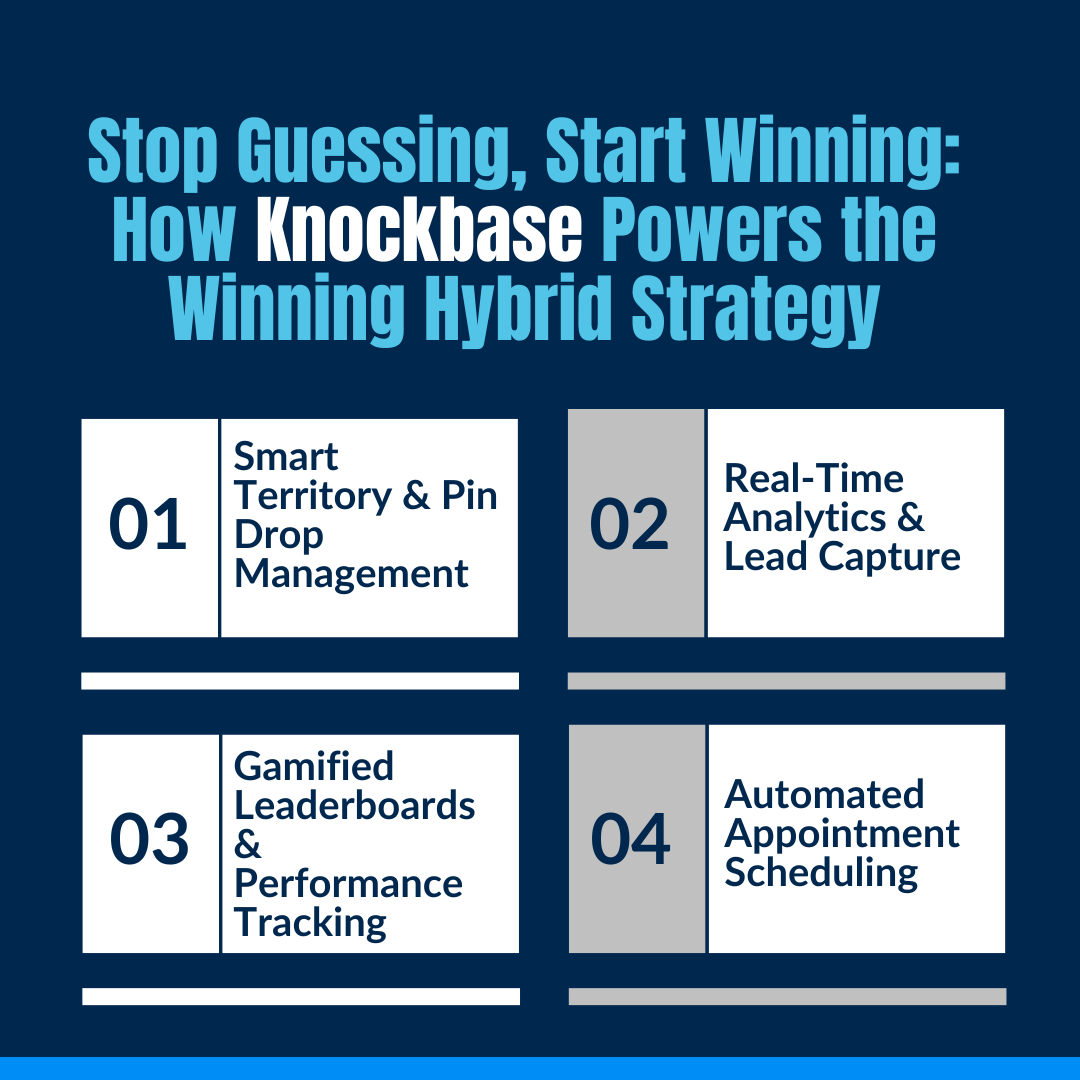
Knockbase transforms D2D vs digital marketing from theory into a finely tuned, real-world marketing strategy. It’s the engine that seamlessly blends door-to-door marketing with digital tools, making both channels stronger together:
- Smart Territory Management & Geo-Tagging: Define zones, drop pins, and eliminate overlaps to ensure full coverage and balanced team workloads.
- Real-Time Analytics & Canvass Reporting: Instantly sync every interaction, lead, and note. Use live dashboards for data-driven coaching and performance insights.
- Gamified Leaderboards & Performance Tracking: Motivate reps with live stats, friendly competition, and a transparent, real-time Knockbase Commission Calculator.
- Automated Appointment Scheduling: Reps book qualified visits directly in the app, complete with automated reminders and calendar syncing, to eliminate friction.
- Lead Scoring & Prioritization: Automatically rank leads based on interest or proximity, directing reps to the highest-potential prospects.
- Mobile-First Experience & Offline Mode: The app operates fully offline, capturing all data (leads, notes, and appointments) and syncing automatically when the signal is restored.
- Custom Forms & Surveys: Design and deploy customizable digital forms to capture essential, specific prospect information on-site.
- Smart Route Optimization: Plan the most efficient routes in minutes to maximize the number of doors knocked and minimize wasted driving time.
- CRM Integration & Workflow Sync: Connect seamlessly to your existing CRM for automated two-way data flow of leads and sales outcomes.
- Team Collaboration Tools: Utilize built-in messaging, shared notes, and task assignments to keep field reps and managers aligned.
Knockbase brings everything together: route planning, lead management, team motivation, and digital nurturing, making hybrid door marketing and online marketing both effortless and exceptionally effective.
Bringing It All Together
Ultimately, the debate between D2D and digital marketing isn’t about choosing one over the other; it’s about integration.
Door-to-door marketing brings the human touch, personal interaction, and trust that no algorithm can match, while digital marketing delivers scale, automation, and long-term nurturing.
Together, they form a marketing strategy that converts leads into loyal customers, by combining face-to-face interaction with digital tools, home service businesses can build stronger brands, deeper relationships, and sustainable growth in the digital age.
About Knockbase
Knockbase helps home service businesses streamline lead management by connecting door-to-door efforts with digital marketing on a single, smart platform.
Schedule your demo today and see how easy growth can be!
FAQs
1. Is direct marketing the same as digital marketing?
No. Direct marketing involves reaching customers directly through methods such as door-to-door sales or mail, while digital marketing utilizes online platforms, data, and technology to engage, track, and convert audiences.
2. Which is better, supply chain or digital marketing?
The supply chain ensures product availability and delivery efficiency, while digital marketing drives demand and increases awareness. One isn’t “better”; they complement each other, supply chain manages logistics, and digital marketing fuels growth.
3. What is the difference between drop shipping and digital marketing?
Dropshipping is a business model where products are sold without holding inventory, relying on suppliers to fulfill orders. Digital marketing, however, is a set of strategies using online tools to attract, engage, and convert customers.


